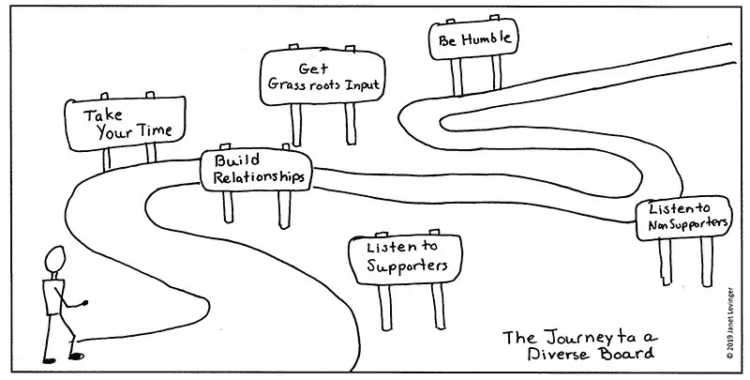Every board I have served on has wanted to be more diverse – more diverse in many ways: by race and culture, by age and gender, by geography. Yet most boards don’t do a good job at achieving the diversity they strive for. In this post, one ED shares his journey to a truly diverse board. His primary lessons – take your time, build trust, listen, be humble.
Diversity is important – having many voices at the table changes not only the conversation but also decisions made and actions taken. Creating a diverse board sends a powerful signal to staff, clients, donors, and the community. It says that you are truly committed to meeting the needs of your community and are starting at the top. Getting the first few diverse board members can be the hardest – they don’t want to be tokens. You have to prove to them that you are sincere in your goals and you can’t expect them to do all the hard work.
A Diverse Board Changed the Conversation – and Our Strategy
From an Executive Director somewhere in the US
We are a state affiliate of a national organization. I am a white male and serve as the Executive Director for the state. The board is an advisory board, not a governing board, and is charged with strategy, advocacy, and championing the organization.
When we started, everyone was white. We set the goal that the board would be at least 50% people of color. We decided not to add any new board members until we had a diverse pipeline. Two years later, we had a 13-person board with seven people of color. The board is also diverse around roles, geography, and age. I have people on the board from different areas of the field. We are a state which has urban areas and rural areas and we have members from both. We also have people who are different ages.
The nature of our conversations is much better because of our diversity. I serve on other boards which are not diverse, and the conversations are different. Having different voices led to us change our strategy. And I believe that diversity has brought much humility to the room — particularly for the white people.
We Developed an Intentional Process
We set out in an intentional way to create a diverse board. I spent a lot of time seeking advice from people who had created boards before. One advisor had been on many boards including a startup. He was very methodical. He had spreadsheets. He counseled me to know what type of people we were looking for – diversity and roles. Then to look at what we already had and what we needed. Once I had that, he told me to get as many names as I could find.
We had a process. First, we developed a matrix of what we wanted. Then, we identified a few new board members who were people of color and well-respected, and who would appeal to other people who might want to join the board. Having these individuals would cause others to say, “Okay look, they are off to a start that is different than what we expected.” We worked hard to get these people.
We asked our board and our partners to help identify anyone who would fit our criteria which included diversity, but also other criteria. We went outside our organization and talked to lots of people. I looked through lists of all the organizations I respect and reached out, trying to identify connectors.
I did all the outreach at the beginning. I asked the board how they wanted to be involved. They said they would help with criteria and names, and they trusted me to pick the people. I did that for the first couple new board members. Then I thought I would rather have board members engaged. So, we started a process where prospects met with me, with the chair, and with the vice chair. Then the three of us would have a conversation before coming to the whole board. In some cases, we would take them on site visits so they could see what we are doing. We talked about our vision and direction and how we were growing as an organization, moving more deeply into diversity work. We looked for respected leaders of color who could speak on our behalf about our impact and how we had changed over time. We had a lot of conversations.
As a White Person, I Worked Hard to Be Humble
Separately, I was doing my own work: how does a white ED working on race and equity be super humble? I had to be humble about what I said and how we approached people. I think that probably had more effect than I realized at the time because I was honest about my personal journey and recognized my privilege. We were really open. I think that helped a lot.
As I said, we have board members from both urban and rural areas. Connecting in rural areas was hard work; I spent a lot of time meeting community leaders, talking to community leaders, listening. I often asked myself “How do I keep doing this work without showing up like a white savior?”
Once we hit a tipping point, once we got to four of nine people of color, it made it easier to recruit more people of color. I had board members who were people of color join me in my meetings with prospective board members.
Lessons Learned
Take the time to build relationships: There is plenty we could have done differently. I think having a matrix and criteria are not relational enough. We ended up going too fast. In the future, I would go slower to identify which communities to work with and to develop relationships in those communities, especially in rural areas. You have to get to know people.
Get grass roots input. Many of our leaders of color were fairly privileged in terms of wealth – and we needed that frankly. But I don’t think we did enough deep dive work with local organizations working at the grass roots level. I think we should have done more there.
Tap into trusted people, listen, and be humble. There are also things I would do again. For example, I would absolutely tap into trusted people. I would listen a lot to what drives people and why they want to engage. I would definitely show up as humble as possible and I would definitely get representatives from urban and rural areas.
Realize everyone has something to contribute. We also talked about how we treat the younger people who joined the board. We knew we had to be very careful not to assume that just because they were young, they did not have a lot to contribute.
Listen to supporters and non-supporters. Finally, we talked to individuals who are not big fans of our work as well as those who are very supportive. That was intentional, having non-supporters give us input to what we should do. I know our organization is not perfect. I wanted to hear what people were worried about. Because of this, we got a lot clearer on who we are and what our priorities are. I definitely would do this again.
Janet Levinger is a member of the Social Venture Partners global network as a partner in Social Venture Partners Seattle.



